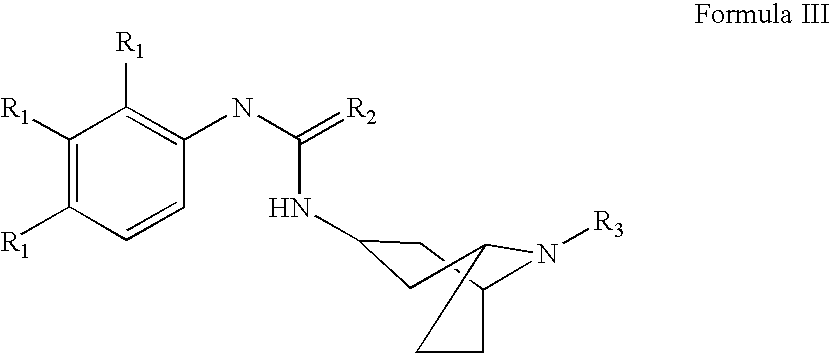Methods and Compositons for Stimulating Neurogenesis and Inhibiting Neuronal Degeneration
a neurogenesis and neuronal degeneration technology, applied in the field of neurology, can solve the problems of neuronal loss, cognitive decline, direct and indirect cost of care for alzheimer's disease patients, and achieve the effect of stimulating neurogenesis
- Summary
- Abstract
- Description
- Claims
- Application Information
AI Technical Summary
Benefits of technology
Problems solved by technology
Method used
Image
Examples
example 1
Preparation of Compounds
Preparation of 2-(1.4)-Diazepan-1-yl-6-ethoxy-quinonline-3-carbonitrile
[0206]A mixture of 2-chloro-6-ethoxyquinoline-3-carbonitrile and homopiperazine (10 equivalents) was heated at 150° C. for 1-2 hours, until reaction was shown to be complete by TLC(CHCl3:MeOH 9:1). After cooling, the reaction was quenched with ice, and extracted in to CHCl3 (X 3), washed with brine, and dried (K2CO3). After removal of the solvent, the product was purified as the oxalic acid salt from acetone.
Preparation of 4-(3-Cyano-6-ethoxy-quinolin-1-yl)-(1,4)diazepane-1-carboxylic acid (2-fluorophenyl)-thioamide.HCl
[0207]1-Isothiocyanato-2-fluorobenzene (1.3 equivalents) was added to a solution of the secondary amine from above in dry acetonitrile. After stirring overnight, the solvent was removed and the product (NNT5) was purified through the hydrochloride salt from acetone.
example 2
Identification of Compounds
[0208]The in vitro neurogenesis test was performed using human neuronal progenitors cells. By way of background, the human neuronal progenitor cells can be cultured in media and have the potential to produce mature functional neurons. The neurogenesis factor in the culture media can promote the number of the progenitor cells which differentiate into neurons. Indeed, it is a widely accepted in vitro model to test a chemical's neurogenetic property.
[0209]Cells were obtained as human neuronal progenitors from a commercial source and were grown for up to three passages or at any time differentiated to potentially produce mature functional neurons in culture. Following two passages to expand the cells, progenitors were seeded into multi-well microplates and the media were changed to differentiation media (minus serum and mitogen). Within 2 hrs of this media change, a vehicle, positive control or test compound were added to each well. Also, they were added with ...
example 3
Examination of Compounds Effectiveness to Inhibit Neuronal Degeneration
[0212]The effective compounds were then subjected to the in vitro neuron degeneration test. This test as applied for neuroprotective discovery involved the ability of the drugs to inhibit apoptosis and necrosis.
[0213]In measuring the ability of inhibiting apoptosis, mature neurons (3-4 weeks following initiation of differentiation) were treated with staurosporine to induce apoptosis. A low concentration of staurosporine (10-100 nM) or beta amyloid 1-42 peptide at 1-10 μM or peptide beta amyloid 25-35 at 10-75 μM concentration was used to stimulate apoptosis. At the same time as treating with staurosporine, the neurons were treated with vehicle or one of the test agents. Because there was strong data demonstrating that staurosporine activated caspase-3 to initiate the apoptotic pathway, the compounds of the invention abilities of inhibiting staurosporine-induced apoptosis were quantified by the amount of activated...
PUM
| Property | Measurement | Unit |
|---|---|---|
| Inhibition | aaaaa | aaaaa |
| Inhibition | aaaaa | aaaaa |
| Inhibition | aaaaa | aaaaa |
Abstract
Description
Claims
Application Information
 Login to View More
Login to View More - R&D
- Intellectual Property
- Life Sciences
- Materials
- Tech Scout
- Unparalleled Data Quality
- Higher Quality Content
- 60% Fewer Hallucinations
Browse by: Latest US Patents, China's latest patents, Technical Efficacy Thesaurus, Application Domain, Technology Topic, Popular Technical Reports.
© 2025 PatSnap. All rights reserved.Legal|Privacy policy|Modern Slavery Act Transparency Statement|Sitemap|About US| Contact US: help@patsnap.com



